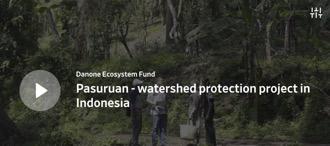This is the first blog in a series leading up to the 2020 WEF Annual Meeting on “Stakeholders for a Cohesive and Sustainable World”
There remains a tremendous opportunity for private and public stakeholders to continue to take action to improve the management of natural capital across the globe. Recent research has found that natural capital makes up approximately 47 percent of wealth in low-income countries and 27 percent in lower-middle-income countries, and that achieving the Sustainable Development Goals (SDGs) could create more than 380 million jobs and help to unlock at least US$12 trillion in opportunities for business by 2030. The growth of this wealth, however, is not about liquidating natural capital to build other assets, but about its more efficient use and sustainable management. Global estimates suggest that ecosystem services provide benefits of US$125-140 trillion per year.
To unlock these opportunities, public and private sector actors are increasingly finding that it is more effective and efficient to collaborate. Below, we feature some of our latest resources and case studies on how multi-stakeholder collaboration can strengthen the sustainable management of natural capital.
Compensating the providers of ecosystem services
In most countries, the costs of natural capital management fall on just a few public and private landowners, while the benefits are widely distributed among downstream beneficiaries. As a result, private ownership of ecosystem services has been a key factor driving the global decline of ecosystem services. To address this, various forms of payments for ecosystem services (PES) have been initiated:
- Water Funds have been adopted by several governments, including Ecuador and Kenya, in partnership with The Nature Conservancy (TNC). These link downstream users to the upstream land stewards through: (i) A funding mechanism that collects funds from water users, government, and NGOs and redistributes them to upstream landowners to support conservation, (ii) A governance mechanism involving a multi-stakeholder board, and (iii) A watershed management mechanism. To support others implementing water funds, TNC has prepared a Water Funds Toolbox.
- Payments for wildlife sightings in Laos, where a pilot project has directly linked the number and type of sightings by tourists with the amount of financial benefits disbursed to communities involved in an ecotourism operation. It covers a range of species using a tiered pricing system. Preliminary results showed that as ecotourism benefits rose, hunting infractions decreased and wildlife sightings increased. Learn about similar examples of PES for ecotourism being implemented in other countries.
Addressing shared public-private challenges for sustaining natural capital
Public and private sector stakeholders are increasingly finding that, by bringing together their respective expertise, skills, and financing, they are achieving greater impact in addressing the shared challenges of sustainable development. This has recently been featured in resources on the agriculture sector, with one report finding that there is an estimated US$4.5 trillion annual opportunity for businesses which transform food and land use by 2030. Recent on-the-ground projects include:
- In Indonesia, Danone and ICRAF joined forces with public authorities to invest in land management and improve water quality and quantity. In Pasuruan, home to a Danone bottled water facility, it is projected that failure to protect the watershed will result in zero water discharge by 2040. The project responds with watershed conservation activities in horticulture upstream, complex agroforestry at midstream, and rice fields downstream. Support is provided to help farmers adopt sustainable innovations and reduce downside risks from the transition.
- The World Cocoa Foundation is working with the governments of Côte d’Ivoire and Ghana and 34 cocoa and chocolate companies on the Cocoa & Forests Initiative to address the challenge of growing cocoa demand and diminishing forests. In March 2019, all stakeholders agreed to action plans for both countries that spelled out concrete steps to end cocoa-related deforestation and promote climate-smart cocoa production.
Improving information for decision-making on natural capital investments
For governments, conducting natural capital assessments enables better informed green growth decision-making with better returns on investment. Likewise, businesses and financial institutions that conduct environmental, social, and governance (ESG) assessments have a better understanding of the risks (e.g. resource scarcity, increased input costs), opportunities (e.g. cost savings, increased market share, long-term viability of business models), and net impacts associated with investment decisions. However, valuation studies quantifying these benefits and impacts remain limited, and there are a number of data barriers to effective natural capital assessment. Examples of resources to help stakeholders better incorporate natural capital valuation into green growth decision-making have been featured in recent research by GGKP partners such as WAVES and SEEA. Two additional examples are:
- Recent analysis of two coral reef systems — the Mesoamerica Reef and the Coral Triangle — has estimated their economic value at US$6.2 billion and US$13.9 billion per year, respectively, across tourism, commercial fisheries, and coastal development. However, the reefs are in decline. Unchecked, this could lead to an annual loss of value of US$3.1 billion in Mesoamerica and US$2.2 billion in the Coral Triangle by 2030. By contrast, a healthy reef scenario is expected to deliver additional economic benefits amounting to US$35 billion and US$37 billion. In particular, the study's evaluation of a range of policies and interventions found that the highest potential return on investment in Mesoamerica would be for the expansion of no-take marine protected areas (44:1) and, in the Coral Triangle, for better erosion management on agricultural land near coastal areas in Indonesia (9:1).
- An assessment in the Cayman Islands based on the Economics of Ecosystems and Biodiversity (TEEB) found that the ecosystem services obtained from coral reefs, mangroves, seagrasses, and beaches provide a total economic value of at least US$179 million per year. In a comparison of two policy scenarios, the study found that expanding and restructuring marine protected areas (MPAs) according to the government’s proposed plan would result in at least 7 percent greater total net benefits than maintaining the current network of MPAs. The findings also showed that tourists have a high willingness to pay for nature conservation in the Cayman Islands, suggesting that current environmental fees could be re-evaluated without having a substantial effect on the number of tourists visiting.
TAKE ACTION
- ENGAGE with the GGKP Expert Working Group on Natural Capital
- DISCOVER What’s New: Stay up to date on the latest knowledge via Twitter, LinkedIn, Facebook, and GGKP's Knowledge Update Newsletter
ADDITIONAL READING
The opinions expressed herein are solely those of the authors and do not necessarily reflect the official views of the GGKP or its Partners.





